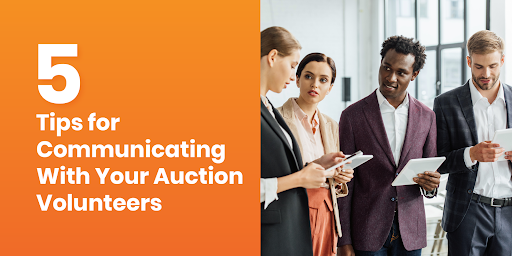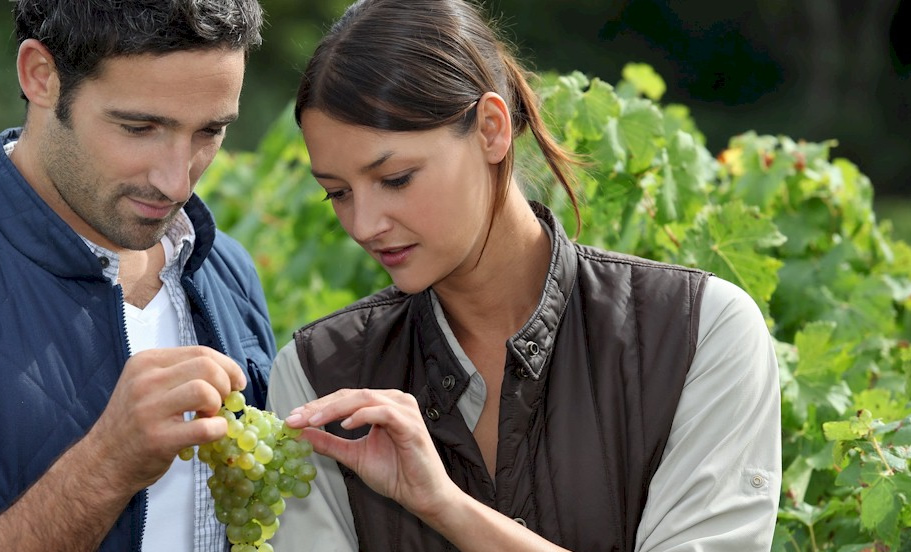As a volunteer coordinator, you know the importance of establishing a reliable team of passionate volunteers. These supporters play a huge role in the success of your fundraisers.
It’s your responsibility to be clear about volunteer roles and expectations to run a successful charity auction fundraiser. Communicate what their responsibilities will be throughout the auction, express appreciation for their hard work, and ensure they understand the value of their contributions.
This guide will explore five tips for communicating with your auction volunteers:
- Segment your audience.
- Clearly explain expectations and desired outcomes.
- Use a multichannel communication strategy.
- Make your communications a two-way street.
- Express your gratitude for volunteers.
The foundation of your organization’s auction planning process should be built on effective communications, from your marketing materials to your follow-up outreach. But before you can start reaching out to supporters, you have to nail down communications internally. Let’s dive in to learn about how these volunteer communication tips can boost your auctions!
1. Segment your audience.
Segmentation is the process of dividing your volunteer pool into smaller groups based on shared traits such as skills, interests, and experience level. Using audience segmentation to guide your communications allows you to:
- Stay organized. You can better delegate tasks to a large number of people when they’re divided into smaller, more manageable groups. For instance, after deciding which group would be best suited to handle a specific task during the auction, contact them directly. Audience grouping also allows you to easily send updates or instructions to each pre-defined group during the auction if any unexpected tasks arise.
- Target communications. Segmented groups allow you to send more personal, relevant communications. Directing relevant information to the right people simplifies explanations of roles and details about tasks.
- Increase engagement. Your auction volunteers will be attentive to messages when they are applicable to their roles and interests. In the long run, more targeted communications will engage those who work for you by setting the precedent that all of your messages will be relevant and important.
Crafting tailored messages for each volunteer group will boost the overall efficiency of your efforts. Choose constituent relationship management (CRM) software to help you organize this information and automate your messages. This will save you a lot of time in outreach and keep necessary information well-structured so you can continue planning other parts of the auction.
2. Clearly explain expectations and desired outcomes.
A crucial part of assigning roles to volunteers is being clear about what their actions should accomplish. Bloomerang’s volunteer recruitment guide explains you’ll attract more volunteers when you provide a clear description of the role, including its overall importance in relation to your organization’s mission. Volunteers will stay motivated when they have a concrete idea of the impact their work will have.
To communicate your expectations and desired outcomes for the auction, you might:
- Practice situational leadership. Adjust your communication and management style to adapt to different situations with different groups of people. For instance, you might communicate with your older volunteers differently than with your younger volunteers. Similarly, you might offer more guidance to your new volunteers, while giving your long-time volunteers greater responsibility and freedom.
- Define what success looks like. As a leader, you should motivate your volunteers to perform at the highest level. Define what success looks like for volunteers and how they can work effectively to boost your auction. For instance, you might explain that your auction helps fund your organization’s after-school gardening program for local kids. Let volunteers know that because of their help, you’re able to set up and break down the auction easily, meaning your staff can focus on soliciting bids that will go toward purchasing new planters.
- Check-in regularly with volunteers. Checking in with your volunteers allows you to communicate updates and continuously thank them for their hard work at your auction. This helps you keep your volunteers on track and engaged. You can also reward volunteers who are doing a particularly good job so they’re aware that you notice their achievements.
In addition to making your auction run more smoothly, clear expectations can also help your organization in the long run. Prospective volunteers will feel much more comfortable about signing up because they’ll know what’s expected of them. Not only does this attract more volunteers to your cause, but it also allows you to provide guidance and support for accomplishing those goals.
3. Use a multichannel communication strategy.
A multichannel communication strategy involves leveraging several different platforms to reach your volunteers. Sending messages through email, social media, your website, texts, phone calls, or mobile app notifications can deliver important information to the right people at the right time.
Each platform has its own strengths and is suited for delivering different types of information. You might use:
- Email to send detailed information about an upcoming event.
- A text message to send a quick, time-sensitive notification about moving your auction indoors due to rain.
- A mobile app notification to remind volunteers about upcoming auction tasks.
- An eCard for an appreciation message after your auction concludes.
Certain methods of communication will be more effective for reaching specific volunteers when they align with communication preferences. For example, some volunteers might check their text messages more frequently than their social media accounts, so an urgent message would be better received as a text. Use the information you gathered during volunteer registration to determine how your supporters respond to different platforms.
You can also leverage volunteer management software to centralize all of your communications across different platforms. Certain apps offer multiple communication options such as email, SMS, and in-app messaging. They might also include features such as self-check-in and attendance tracking to help your volunteers carry out their tasks at the auction.
4. Make your communications a two-way street.
Two-way communication creates an environment where volunteers can share their thoughts and ideas. Ensure your volunteers know who to go to for any questions they have throughout the auction. And, once the auction concludes, send a post-event survey to gather volunteer feedback.
It’s essential to get feedback from your volunteers because you want them to feel valued and show that their opinions matter to your organization. Plus, you can use their feedback to improve future volunteer opportunities and make them more appealing to supporters. Just as you’d collect data to understand your auction donors, you can also collect information from your volunteers to better their experience of working with your organization.
5. Express your gratitude for volunteers.
Your volunteer communication strategy shouldn’t end right after your auction is over. Showing genuine appreciation for your volunteers’ efforts will result in greater volunteer satisfaction and retention. When your supporters feel recognized, they’re more likely to feel connected to your program and continue their involvement.
eCardWidget’s guide to donor recognition recommends using segmentation strategies to target your recognition messages. If you’ve already categorized volunteers for event communications, you can use these same groups to target your message! For example, you might use this information to thank a group of donors who managed a mishap with item procurement.
For more practical ways to show your gratitude, you might:
- Feature volunteers on your website. Showing recognition on one of your blogs can be an excellent way to show your community your appreciation for your volunteer’s hard work! This allows your volunteers to feel special and acknowledged.
- Give a shout-out on your social media platforms. You can leverage the power of your social media presence by sharing an appreciation post or a story about your volunteers. Be sure to make the posts shareable so volunteers can repost them to their own pages!
- Give your volunteers awards or certificates. Were there volunteers who went above and beyond at the auction? You can nominate them for awards such as “Volunteer of the Year” to show your heartfelt appreciation.
- Write a personal thank-you letter. A handwritten, customized thank-you letter is one of the simplest but most powerful ways to show appreciation.
Remember to share specific results from your auction event, such as how much money you were able to raise during the event. Numbers help volunteers visualize how much their help made a difference in your auction.
Your volunteers’ contributions play an impactful role in the success of your auction. Think about how you will divide your team of volunteers, explain desired outcomes, determine which forms of communication will be most effective, and show gratitude for all their hard work!
Implementing efficient volunteer communication strategies will help ensure the success of your event and create an enjoyable experience for your team of hardworking volunteers.




